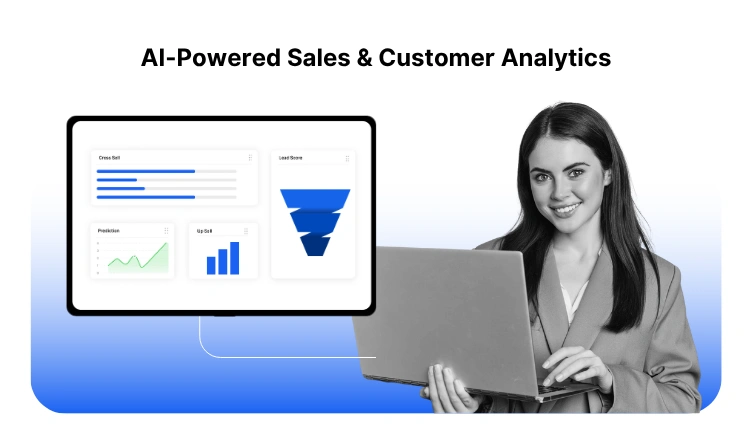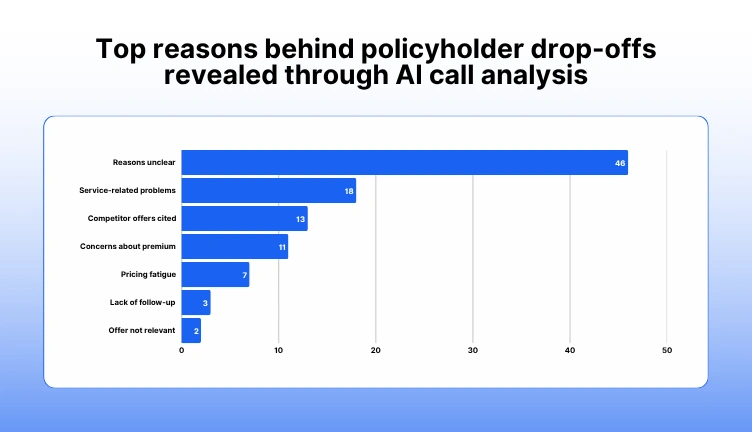The insurance industry is facing mounting pressure to perform. Faster sales cycles, lower churn, and smarter risk decisions are no longer optional. Yet many insurers still operate with siloed data, rigid underwriting models, and reactive retention strategies.
Sales inefficiency is a persistent challenge. Agents often spend time on low-quality leads while high-intent prospects go unnoticed.
According to McKinsey, insurers using predictive analytics for lead scoring have improved conversion rates by up to 20%.
Customer retention is another key concern. Generic renewal reminders and post-churn discounts are too little, too late. A Bain study found that AI-powered retention models, which identify early signs of disengagement, can increase loyalty by 15 to 25%.
The issue of inaccurate risk assessment also persists. Traditional underwriting overlooks dynamic risk factors such as behavior, lifestyle, and real-time health data.
In contrast, John Hancock’s Vitality program adjusts life insurance premiums using wearable data, rewarding active and healthy policyholders.
Fraud adds further pressure. Fraudulent claims cost insurers billions each year. Tools like Shift Technology have helped AXA detect suspicious patterns early, reducing fraud losses and improving claims accuracy.
Low sales precision, churn, risk mispricing, and fraud exposure are not isolated problems. They are industry-wide gaps that AI analytics is now solving with speed, scale, and accuracy.
Start building your data advantage with AI analytics.
Why AI Analytics is Gaining Ground in Insurance

For insurers, AI analytics is no longer a pipe dream. It is now essential to how insurance companies increase retention, expedite sales, and make quicker, more intelligent decisions. This shift is being driven by three pressing realities.
1. Changing customer behavior and rising competition
Insurance customers today expect experiences like those from e-commerce or fintech to be personalized, digital-first, and immediate. Unfortunately, many traditional insurers still rely on rigid processes and broad segmentation.
- 41% of insurance customers are likely to switch providers due to poor digital experiences (PwC).
- InsurTechs use AI-powered chatbots, instant pricing engines, and behavioral data to set new service benchmarks.
To keep up, incumbents need AI tools that provide visibility into customer intent, preferences, and lifecycle behavior.
2. The cost of sales inefficiency and customer churn
Selling insurance is expensive, and losing customers is even more costly.
- Acquiring a new customer can cost 5 to 10 times more than retaining one (Forrester).
- Agents often chase low-value leads due to poor targeting.
- Churn happens silently when early warning signs are missed.
AI analytics improves lead scoring and helps identify the most profitable cross-sell and upsell opportunities. On the retention front, churn prediction models flag at-risk policyholders before they leave.
3. Urgency for real-time, data-driven decision-making
Legacy systems can’t process the volume or speed of data now required to compete.
- Real-time risk scoring is essential for dynamic pricing.
- IoT data from vehicles and homes needs to be processed instantly.
- Fraud detection and claims processing must evolve from reactive to proactive.
AI models continuously scan internal and external data, enabling underwriters, claims teams, and marketers to act immediately.
Explore how data drives smarter, faster, and more profitable decisions.
Smarter Sales and Personalization with Predictive Analytics

Insurance sales are becoming increasingly data-driven. Predictive analytics, powered by historical claims data, behavioral inputs, and machine learning, is helping insurers move from guesswork to precision in how they approach prospects and policyholders.
Instead of relying on traditional segmentation or cold outreach, insurers are now using AI analytics to identify and prioritize high-quality leads. These systems analyze digital behavior such as product page visits, quote completions, and form abandonment, and combine it with CRM data and demographic factors to predict buying intent.
But it doesn't stop at acquisition. AI is equally effective in uncovering upsell and cross-sell opportunities. A policyholder with home insurance, for instance, who frequently travels or searches for health plans may be an ideal candidate for bundled travel or health coverage.
Predictive models can detect these subtle cues and trigger timely product suggestions. Allianz successfully used such modeling to expand product adoption among existing customers, improving their average revenue per user.
What makes AI-driven personalization especially powerful is its ability to go beyond static customer segments. Instead of grouping people by age or location alone, AI systems build dynamic, evolving profiles using real-time behavior, past claims, lifestyle events, and even sentiment from customer support interactions.
This leads to hyper-personalized offers and communications that feel relevant and timely, like AXA’s email campaigns, which saw a 3x increase in engagement through machine learning-powered personalization.
Ultimately, predictive analytics shifts insurance sales from being reactive and generic to proactive and targeted, making every interaction more relevant, efficient, and likely to convert.
Move from broad strokes to precision targeting with AI.
This blog is just the start.
Unlock the power of Convin’s AI with a live demo.

Retention Strategies Built on Churn and Uplift Models

Customer retention is essential to long-term profitability in the insurance business. While acquiring new policyholders is important, retaining existing ones is more cost-efficient and directly tied to lifetime value.
With AI analytics, insurers can finally shift from reactive renewals to proactive, personalized retention strategies.
- Predicting churn early
AI models can identify subtle signals that indicate a customer is likely to leave. These models draw insights from:
- Payment delays or lapses in policy engagement
- Fewer interactions with digital platforms
- Negative sentiment in customer support calls
- Claim denials or long processing times
These signals are often missed through manual processes. With predictive analytics, insurers can flag at-risk policyholders and take action before churn becomes irreversible.
- Knowing who is worth saving
Not all customers who might churn will respond to retention efforts. That is where uplift modeling plays a critical role.
- It identifies which policyholders are most likely to respond positively to retention outreach
- It prevents unnecessary offers or discounts to customers who would stay anyway
- It ensures marketing budgets are focused where they matter most
By combining churn and uplift insights, insurers can personalize retention strategies and avoid wasteful interventions.
- Personalizing outreach that works
AI also helps determine the best way to reach each customer. Some respond better to a direct agent call, while others prefer digital nudges like emails or app reminders. AI models learn these preferences and adjust accordingly, creating retention journeys that feel timely and relevant.
Enhancing Core Functions with AI
Beyond sales and marketing, AI analytics is quietly but powerfully transforming the operational backbone of insurance. From underwriting and pricing to fraud detection and claims processing, AI delivers the accuracy, speed, and scalability that traditional systems lack.
Underwriting and Pricing
AI enhances decision-making at the very start of the policy lifecycle.
Key benefits:
- Enables contextual risk scoring using behavioral and real-time data
- Automates underwriting workflows to reduce manual errors
- Supports dynamic pricing tailored to individual risk profiles
- Aligns premium accuracy with changing risk conditions
Claims Processing
AI reduces delays and simplifies the high-volume nature of claims handling.
Key benefits:
- Extracts data from claim forms, documents, and communications
- Categorizes and prioritizes claims by complexity or urgency
- Flags incomplete submissions for faster resolution
- Improves response time and consistency in claim decisions
Fraud Detection
Fraud detection becomes more scalable and proactive with machine learning.
Key benefits:
- Detects suspicious behavior through data anomalies and inconsistencies
- Monitors claim patterns to isolate outliers or abnormal trends
- Supports early fraud alerts to reduce potential loss
- Lowers false positives through model refinement over time
Governance and Compliance
Operational AI must be responsible, traceable, and audit-ready.
Key requirements:
- Ensure decision transparency with explainable AI tools
- Maintain clean, structured data pipelines for reliability
- Track model performance across different customer groups
- Stay aligned with evolving regulatory standards
Upgrade your core systems with AI to deliver faster, fairer, and more intelligent insurance operations.
Use AI to act early, focus smart, and retain more of your best customers.
Practical Implications and the Convin Advantage
Insurers around the world are increasingly turning to AI analytics to drive measurable improvements in both top-line growth and operational efficiency. From improving customer satisfaction to enabling more accurate risk assessment, the impact of predictive insurance analytics is clear.
Performance metrics from leading insurers
Several global insurers have adopted AI-powered analytics to streamline operations and optimize customer journeys:
- One European insurer increased its policyholder renewal rates by 20 percent after deploying a churn prediction engine powered by behavioral and claims data.
- A U.S.-based health insurance provider reduced fraudulent claims by 25 percent using anomaly detection models that flagged suspicious claims data early.
- An Asian life insurer used lead scoring and intent modeling to boost conversion rates by 18 percent while lowering acquisition costs.
These applications demonstrate that AI is achieving tangible business results and is no longer merely an experimental technology.
Case Study: How a Leading Insurance Provider Used Convin's AI Analytics to Reduce Policyholder Drop-Offs and Improve Retention Strategy

Background
A premium insurance company was dealing with a concerning trend: policyholders were leaving at a faster rate than anticipated during the retention period.
Although the company had invested in call centers, CRM systems, and agent training, it lacked visibility into why customers were disengaging or refusing to renew.
The result was rising churn, lower renewals, and stagnant sales efficiency.
The company partnered with Convin to bring AI-powered conversation intelligence into its retention and renewal operations.
Challenge
Despite having a mature retention team in place, the company struggled with:
- Inconsistent documentation of reasons behind customer refusals
- Missed early indicators of churn due to lack of call analysis
- Broad, generic retention campaigns that yielded limited ROI
- No systematic way to segment and act on behavioral feedback from customers
Solution: AI-Powered Conversation Analytics with Convin
Convin deployed its AI analytics platform to analyze over 90,000 customer interactions from the company’s retention channel. The goal was to decode patterns in customer language, tone, intent, and objection handling that agents couldn’t consistently track or act upon.
Using natural language processing and intent detection models, Convin automatically categorized reasons for customer drop-off into structured, actionable themes. These were not based on rigid CRM tags but dynamically learned from actual customer conversations.
Key Insights Uncovered
Convin’s AI uncovered eight primary themes contributing to lost renewals. Among these:
- Nearly half of all drop-offs stemmed from vague or undisclosed objections, signaling poor probing or lack of rapport during calls
- A significant chunk cited service dissatisfaction, indicating unresolved claims or delayed support were hurting renewal intent
- A smaller but notable segment referenced better deals from rival insurers, revealing competitive leakage
- Others mentioned pricing fatigue, lack of follow-up, or irrelevant offers, pointing to gaps in personalization and follow-through
Instead of relying on static call outcomes like "Not Interested" or "No Reason Given," Convin’s AI revealed granular, hidden causes behind customer decisions.
Business Impact
With these insights, the insurer redesigned its retention playbook:
- Trained agents to handle soft objections more effectively using real-time coaching prompts from Convin
- Created dynamic scripts based on intent profiles, improving customer engagement across different personas
- Launched a proactive callback strategy for at-risk customers flagged by the platform’s churn prediction models
- Optimized retention campaigns by aligning messaging with dominant drop-off themes
Over the next quarter, the insurer reported:
- A 19% improvement in customer retention rate across key geographies
- A 25% increase in win-back conversions through targeted follow-ups
- A noticeable reduction in repeat objections, thanks to coaching on root-cause rebuttals
Conclusion
By leveraging Convin’s AI analytics, the insurer turned unstructured conversations into a data goldmine. They switched to a proactive retention strategy based on actual insights rather than conjecture from reactive churn management.
Rebuild insurance operations with real intelligence.
Looking Ahead with AI in Insurance
The future of insurance belongs to those who can move fast, stay data-driven, and deliver personalized experiences at scale. AI analytics has evolved from a value-added service to the basis for more intelligent decision-making, effective business processes, and enhanced customer interaction.
From optimizing sales conversations to enhancing claims and underwriting processes, AI helps insurers uncover patterns, reduce inefficiencies, and stay ahead of customer expectations. It makes use of insurance data so that teams can concentrate on what really counts: providing value and fostering trust.
Turn insights into impact. Get your Convin demo now.
Background
A premium insurance company was dealing with a concerning trend: policyholders were leaving at a faster rate than anticipated during the retention period.
Although the company had invested in call centers, CRM systems, and agent training, it lacked visibility into why customers were disengaging or refusing to renew.
The result was rising churn, lower renewals, and stagnant sales efficiency.
The company partnered with Convin to bring AI-powered conversation intelligence into its retention and renewal operations.
Challenge
Despite having a mature retention team in place, the company struggled with:
- Inconsistent documentation of reasons behind customer refusals
- Missed early indicators of churn due to lack of call analysis
- Broad, generic retention campaigns that yielded limited ROI
- No systematic way to segment and act on behavioral feedback from customers
Solution: AI-Powered Conversation Analytics with Convin
Convin deployed its AI analytics platform to analyze over 90,000 customer interactions from the company’s retention channel. The goal was to decode patterns in customer language, tone, intent, and objection handling that agents couldn’t consistently track or act upon.
Using natural language processing and intent detection models, Convin automatically categorized reasons for customer drop-off into structured, actionable themes. These were not based on rigid CRM tags but dynamically learned from actual customer conversations.
Key Insights Uncovered
Convin’s AI uncovered eight primary themes contributing to lost renewals. Among these:
- Nearly half of all drop-offs stemmed from vague or undisclosed objections, signaling poor probing or lack of rapport during calls
- A significant chunk cited service dissatisfaction, indicating unresolved claims or delayed support were hurting renewal intent
- A smaller but notable segment referenced better deals from rival insurers, revealing competitive leakage
- Others mentioned pricing fatigue, lack of follow-up, or irrelevant offers, pointing to gaps in personalization and follow-through
Instead of relying on static call outcomes like "Not Interested" or "No Reason Given," Convin’s AI revealed granular, hidden causes behind customer decisions.
Business Impact
With these insights, the insurer redesigned its retention playbook:
- Trained agents to handle soft objections more effectively using real-time coaching prompts from Convin
- Created dynamic scripts based on intent profiles, improving customer engagement across different personas
- Launched a proactive callback strategy for at-risk customers flagged by the platform’s churn prediction models
- Optimized retention campaigns by aligning messaging with dominant drop-off themes
Over the next quarter, the insurer reported:
- A 19% improvement in customer retention rate across key geographies
- A 25% increase in win-back conversions through targeted follow-ups
- A noticeable reduction in repeat objections, thanks to coaching on root-cause rebuttals
Conclusion
By leveraging Convin’s AI analytics, the insurer turned unstructured conversations into a data goldmine. They switched to a proactive retention strategy based on actual insights rather than conjecture from reactive churn management.
Rebuild insurance operations with real intelligence.
Looking Ahead with AI in Insurance
The future of insurance belongs to those who can move fast, stay data-driven, and deliver personalized experiences at scale. AI analytics has evolved from a value-added service to the basis for more intelligent decision-making, effective business processes, and enhanced customer interaction.
From optimizing sales conversations to enhancing claims and underwriting processes, AI helps insurers uncover patterns, reduce inefficiencies, and stay ahead of customer expectations. It makes use of insurance data so that teams can concentrate on what really counts: providing value and fostering trust.
Turn insights into impact. Get your Convin demo now.
Background
A premium insurance company was dealing with a concerning trend: policyholders were leaving at a faster rate than anticipated during the retention period.
Although the company had invested in call centers, CRM systems, and agent training, it lacked visibility into why customers were disengaging or refusing to renew.
The result was rising churn, lower renewals, and stagnant sales efficiency.
The company partnered with Convin to bring AI-powered conversation intelligence into its retention and renewal operations.
Challenge
Despite having a mature retention team in place, the company struggled with:
- Inconsistent documentation of reasons behind customer refusals
- Missed early indicators of churn due to lack of call analysis
- Broad, generic retention campaigns that yielded limited ROI
- No systematic way to segment and act on behavioral feedback from customers
Solution: AI-Powered Conversation Analytics with Convin
Convin deployed its AI analytics platform to analyze over 90,000 customer interactions from the company’s retention channel. The goal was to decode patterns in customer language, tone, intent, and objection handling that agents couldn’t consistently track or act upon.
Using natural language processing and intent detection models, Convin automatically categorized reasons for customer drop-off into structured, actionable themes. These were not based on rigid CRM tags but dynamically learned from actual customer conversations.
Key Insights Uncovered
Convin’s AI uncovered eight primary themes contributing to lost renewals. Among these:
- Nearly half of all drop-offs stemmed from vague or undisclosed objections, signaling poor probing or lack of rapport during calls
- A significant chunk cited service dissatisfaction, indicating unresolved claims or delayed support were hurting renewal intent
- A smaller but notable segment referenced better deals from rival insurers, revealing competitive leakage
- Others mentioned pricing fatigue, lack of follow-up, or irrelevant offers, pointing to gaps in personalization and follow-through
Instead of relying on static call outcomes like "Not Interested" or "No Reason Given," Convin’s AI revealed granular, hidden causes behind customer decisions.
Business Impact
With these insights, the insurer redesigned its retention playbook:
- Trained agents to handle soft objections more effectively using real-time coaching prompts from Convin
- Created dynamic scripts based on intent profiles, improving customer engagement across different personas
- Launched a proactive callback strategy for at-risk customers flagged by the platform’s churn prediction models
- Optimized retention campaigns by aligning messaging with dominant drop-off themes
Over the next quarter, the insurer reported:
- A 19% improvement in customer retention rate across key geographies
- A 25% increase in win-back conversions through targeted follow-ups
- A noticeable reduction in repeat objections, thanks to coaching on root-cause rebuttals
Conclusion
By leveraging Convin’s AI analytics, the insurer turned unstructured conversations into a data goldmine. They switched to a proactive retention strategy based on actual insights rather than conjecture from reactive churn management.
Rebuild insurance operations with real intelligence.
Looking Ahead with AI in Insurance
The future of insurance belongs to those who can move fast, stay data-driven, and deliver personalized experiences at scale. AI analytics has evolved from a value-added service to the basis for more intelligent decision-making, effective business processes, and enhanced customer interaction.
From optimizing sales conversations to enhancing claims and underwriting processes, AI helps insurers uncover patterns, reduce inefficiencies, and stay ahead of customer expectations. It makes use of insurance data so that teams can concentrate on what really counts: providing value and fostering trust.
Turn insights into impact. Get your Convin demo now.







.avif)


.avif)